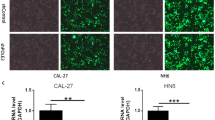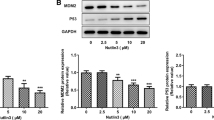Summary
In spite of numerous advances, the 5-year survival rate for head and neck squamous cell cancer has remained largely stagnant and few new anti-tumor drugs have been developed. PCH4, a derivative of n-butylidenephthalide, has been investigated for its anti-tumor effects on oral squamous cell carcinoma (OSCC). The aim of this study was to investigate the anti-tumor mechanism of a potential target gene, Nur77, in OSCC cells, which can be induced by PCH4 treatment. Data show that PCH4 promoted Nur77 translocation from the nucleus to the cytoplasm and induced cell apoptosis in OSCC cells. When Nur77 translocation was blocked, the degree of tumor apoptosis caused by PCH4 was significantly inhibited (p < 0.05). Within the MAPK pathway, PCH4 only induced JNK phosphorylation. Furthermore, treatment with a JNK inhibitor significantly reduced PCH4-induced apoptosis (p < 0.05) and decreased PCH4-induced Nur77 expression (p < 0.05). In a xenograft animal model, administration of PCH4 also showed anti-tumor effects. We have demonstrated that OSCC cells are sensitive to PCH4 and that Nur77 protein translocation from the nucleus to the cytoplasm might be associated with the induction of apoptosis by PCH4. These results indicate that PCH4 may serve as a potential anti-tumor drug for OSCC therapy.





Similar content being viewed by others
Abbreviations
- OSCC:
-
Oral squamous cell carcinoma
- PCH4:
-
(Z)-N-(2-(dimethyl-amino) ethyl)-2-(3-((3-oxo-isobenzofuran- 1(3H)-ylidene) methyl) phenoxy) acetamide)
- BP:
-
butylidenephthalide
- RT-PCR:
-
reverse transcription-polymerase chain reaction
- DMSO:
-
dimethyl sulfoxide
- PCR:
-
polymerase chain reaction
- siRNA:
-
small interfering RNA
- MTT:
-
3-(4,5-dimethyl thizol-2-yl)-2,5-diphenyl tetrazolium bromide
- PVDF:
-
polyvinyldenefluoride
References
Jemal A, Siegel R, Ward E, Murray T, Xu J, Smigal C, Thun MJ (2006) Cancer statistics, 2006. CA Cancer J Clin 56(2):106–130. doi:56/2/106
Lin PC, Chen YL, Chiu SC, Yu YL, Chen SP, Chien MH, Chen KY, Chang WL, Lin SZ, Chiou TW, Harn HJ (2008) Orphan nuclear receptor, nurr-77 was a possible target gene of butylidenephthalide chemotherapy on glioblastoma multiform brain tumor. J Neurochem 106(3):1017–1026. doi:10.1111/j.1471-4159.2008.05432.x
Moll UM, Marchenko N, Zhang XK (2006) P53 and nur77/tr3—transcription factors that directly target mitochondria for cell death induction. Oncogene 25(34):4725–4743. doi:10.1038/sj.onc.1209601
Zhang XK (2007) Targeting nur77 translocation. Expert Opin Ther Targets 11(1):69–79. doi:10.1517/14728222.11.1.69
Li H, Kolluri SK, Gu J, Dawson MI, Cao X, Hobbs PD, Lin B, Chen G, Lu J, Lin F, Xie Z, Fontana JA, Reed JC, Zhang X (2000) Cytochrome c release and apoptosis induced by mitochondrial targeting of nuclear orphan receptor tr3. Science 289(5482):1159–1164. doi:8737
Lin B, Kolluri SK, Lin F, Liu W, Han YH, Cao X, Dawson MI, Reed JC, Zhang XK (2004) Conversion of bcl-2 from protector to killer by interaction with nuclear orphan receptor nur77/tr3. Cell 116(4):527–540. doi:S009286740400162X
Liu S, Wu Q, Ye XF, Cai JH, Huang ZW, Su WJ (2002) Induction of apoptosis by tpa and vp-16 is through translocation of tr3. World J Gastroenterol 8(3):446–450
Chen YL, Jian MH, Lin CC, Kang JC, Chen SP, Lin PC, Hung PJ, Chen JR, Chang WL, Lin SZ, Harn HJ (2008) The induction of orphan nuclear receptor nur77 expression by n-butylenephthalide as pharmaceuticals on hepatocellular carcinoma cell therapy. Mol Pharmacol 74(4):1046–1058. doi:10.1124/mol.107.044800
Shin HJ, Lee BH, Yeo MG, Oh SH, Park JD, Park KK, Chung JH, Moon CK, Lee MO (2004) Induction of orphan nuclear receptor nur77 gene expression and its role in cadmium-induced apoptosis in lung. Carcinogenesis 25(8):1467–1475. doi:10.1093/carcin/bgh135
van Engeland M, Nieland LJ, Ramaekers FC, Schutte B, Reutelingsperger CP (1998) Annexin v-affinity assay: a review on an apoptosis detection system based on phosphatidylserine exposure. Cytometry 31(1):1–9. doi:10.1002/(SICI)1097-0320
Yu YL, Yu SL, Su KJ, Wei CW, Jian MH, Lin PC, Tseng IH, Lin CC, Su CC, Chan DC, Lin SZ, Harn HJ, Chen YL (2010) Extended o6-methylguanine methyltransferase promoter hypermethylation following n-butylidenephthalide combined with 1, 3-bis(2-chloroethyl) -1-nitrosourea (bcnu) on inhibition of human hepatocellular carcinoma cell growth. J Agric Food Chem 58(3):1630–1638. doi:10.1021/jf903043r
Torres K, Horwitz SB (1998) Mechanisms of taxol-induced cell death are concentration dependent. Cancer Res 58(16):3620–3626
Inaoka Y, Yazawa T, Uesaka M, Mizutani T, Yamada K, Miyamoto K (2008) Regulation of ngfi-b/nur77 gene expression in the rat ovary and in leydig tumor cells ma-10. Mol Reprod Dev 75(5):931–939. doi:10.1002/mrd.20788
Martin LJ, Tremblay JJ (2009) The nuclear receptors nur77 and sf1 play additive roles with c-jun through distinct elements on the mouse star promoter. J Mol Endocrinol 42(2):119–129. doi:10.1677/JME-08-0095
Kolluri SK, Bruey-Sedano N, Cao X, Lin B, Lin F, Han YH, Dawson MI, Zhang XK (2003) Mitogenic effect of orphan receptor tr3 and its regulation by mekk1 in lung cancer cells. Mol Cell Biol 23(23):8651–8667
Han YH, Cao X, Lin B, Lin F, Kolluri SK, Stebbins J, Reed JC, Dawson MI, Zhang XK (2006) Regulation of nur77 nuclear export by c-jun n-terminal kinase and akt. Oncogene 25(21):2974–2986. doi:10.1038/sj.onc.1209358
Kovalovsky D, Refojo D, Liberman AC, Hochbaum D, Pereda MP, Coso OA, Stalla GK, Holsboer F, Arzt E (2002) Activation and induction of nur77/nurr1 in corticotrophs by crh/camp: Involvement of calcium, protein kinase a, and mapk pathways. Mol Endocrinol 16(7):1638–1651
Jacobs CM, Boldingh KA, Slagsvold HH, Thoresen GH, Paulsen RE (2004) Erk2 prohibits apoptosis-induced subcellular translocation of orphan nuclear receptor ngfi-b/tr3. J Biol Chem 279(48):50097–50101. doi:10.1074/jbc.M409145200
Bras A, Albar JP, Leonardo E, de Buitrago GG, Martinez AC (2000) Ceramide-induced cell death is independent of the fas/fas ligand pathway and is prevented by nur77 overexpression in a20 b cells. Cell Death Differ 7(3):262–271. doi:10.1038/sj.cdd.4400653
Tsai NM, Chen YL, Lee CC, Lin PC, Cheng YL, Chang WL, Lin SZ, Harn HJ (2006) The natural compound n-butylidenephthalide derived from angelica sinensis inhibits malignant brain tumor growth in vitro and in vivo. J Neurochem 99(4):1251–1262. doi:10.1111/j.1471-4159.2006.04151.x
Knippschild U, Oren M, Deppert W (1996) Abrogation of wild-type p53 mediated growth-inhibition by nuclear exclusion. Oncogene 12(8):1755–1765
Sakai E, Rikimaru K, Ueda M, Matsumoto Y, Ishii N, Enomoto S, Yamamoto H, Tsuchida N (1992) The p53 tumor-suppressor gene and ras oncogene mutations in oral squamous-cell carcinoma. Int J Cancer 52(6):867–872
Sakai E, Tsuchida N (1992) Most human squamous cell carcinomas in the oral cavity contain mutated p53 tumor-suppressor genes. Oncogene 7(5):927–933
Acknowledgements
This work was supported by a Grant from National Science Council of the Republic of China (96-2320-B-039-044-MY3) and China Medical University Hospital of the Republic of China (DMR-99-073).
Conflict of interest statement
The authors declare that there are no conflicts of interest.
Author information
Authors and Affiliations
Corresponding author
Additional information
The last two corresponding authors (Tzyy Wen Chiou and Horng Jyh Harn) contributed equally to this work.
Rights and permissions
About this article
Cite this article
Liu, P.Y., Sheu, J.JC., Lin, P.C. et al. Expression of Nur77 induced by an n-butylidenephthalide derivative promotes apoptosis and inhibits cell growth in oral squamous cell carcinoma. Invest New Drugs 30, 79–89 (2012). https://doi.org/10.1007/s10637-010-9518-z
Received:
Accepted:
Published:
Issue Date:
DOI: https://doi.org/10.1007/s10637-010-9518-z




